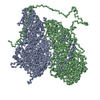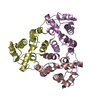+ Open data
Open data
- Basic information
Basic information
| Entry |  | |||||||||
|---|---|---|---|---|---|---|---|---|---|---|
| Title | Rosellinia necatrix megabirnavirus 1-W779 empty capsid | |||||||||
 Map data Map data | ||||||||||
 Sample Sample |
| |||||||||
| Biological species |  Rosellinia necatrix megabirnavirus 1/W779 Rosellinia necatrix megabirnavirus 1/W779 | |||||||||
| Method |  single particle reconstruction / single particle reconstruction /  cryo EM / Resolution: 3.2 Å cryo EM / Resolution: 3.2 Å | |||||||||
 Authors Authors | Wang H / Okamoto K / Miyazaki N / Suzuki N | |||||||||
| Funding support |  Sweden, Sweden,  Japan, 2 items Japan, 2 items
| |||||||||
 Citation Citation |  Journal: PLoS Pathog / Year: 2023 Journal: PLoS Pathog / Year: 2023Title: Capsid structure of a fungal dsRNA megabirnavirus reveals its previously unidentified surface architecture. Authors: Han Wang / Lakha Salaipeth / Naoyuki Miyazaki / Nobuhiro Suzuki / Kenta Okamoto /   Abstract: Rosellinia necatrix megabirnavirus 1-W779 (RnMBV1) is a non-enveloped icosahedral double-stranded (ds)RNA virus that infects the ascomycete fungus Rosellinia necatrix, a causative agent that induces ...Rosellinia necatrix megabirnavirus 1-W779 (RnMBV1) is a non-enveloped icosahedral double-stranded (ds)RNA virus that infects the ascomycete fungus Rosellinia necatrix, a causative agent that induces a lethal plant disease white root rot. Herein, we have first resolved the atomic structure of the RnMBV1 capsid at 3.2 Å resolution using cryo-electron microscopy (cryo-EM) single-particle analysis. Compared with other non-enveloped icosahedral dsRNA viruses, the RnMBV1 capsid protein structure exhibits an extra-long C-terminal arm and a surface protrusion domain. In addition, the previously unrecognized crown proteins are identified in a symmetry-expanded cryo-EM model and are present over the 3-fold axes. These exclusive structural features of the RnMBV1 capsid could have been acquired for playing essential roles in transmission and/or particle assembly of the megabirnaviruses. Our findings, therefore, will reinforce the understanding of how the structural and molecular machineries of the megabirnaviruses influence the virulence of the disease-related ascomycete fungus. | |||||||||
| History |
|
- Structure visualization
Structure visualization
| Supplemental images |
|---|
- Downloads & links
Downloads & links
-EMDB archive
| Map data |  emd_15857.map.gz emd_15857.map.gz | 689.2 MB |  EMDB map data format EMDB map data format | |
|---|---|---|---|---|
| Header (meta data) |  emd-15857-v30.xml emd-15857-v30.xml emd-15857.xml emd-15857.xml | 12.2 KB 12.2 KB | Display Display |  EMDB header EMDB header |
| Images |  emd_15857.png emd_15857.png | 259.5 KB | ||
| Others |  emd_15857_half_map_1.map.gz emd_15857_half_map_1.map.gz emd_15857_half_map_2.map.gz emd_15857_half_map_2.map.gz | 595.5 MB 595.5 MB | ||
| Archive directory |  http://ftp.pdbj.org/pub/emdb/structures/EMD-15857 http://ftp.pdbj.org/pub/emdb/structures/EMD-15857 ftp://ftp.pdbj.org/pub/emdb/structures/EMD-15857 ftp://ftp.pdbj.org/pub/emdb/structures/EMD-15857 | HTTPS FTP |
-Related structure data
- Links
Links
| EMDB pages |  EMDB (EBI/PDBe) / EMDB (EBI/PDBe) /  EMDataResource EMDataResource |
|---|
- Map
Map
| File |  Download / File: emd_15857.map.gz / Format: CCP4 / Size: 744.3 MB / Type: IMAGE STORED AS FLOATING POINT NUMBER (4 BYTES) Download / File: emd_15857.map.gz / Format: CCP4 / Size: 744.3 MB / Type: IMAGE STORED AS FLOATING POINT NUMBER (4 BYTES) | ||||||||||||||||||||||||||||||||||||
|---|---|---|---|---|---|---|---|---|---|---|---|---|---|---|---|---|---|---|---|---|---|---|---|---|---|---|---|---|---|---|---|---|---|---|---|---|---|
| Projections & slices | Image control
Images are generated by Spider. | ||||||||||||||||||||||||||||||||||||
| Voxel size | X=Y=Z: 1.12 Å | ||||||||||||||||||||||||||||||||||||
| Density |
| ||||||||||||||||||||||||||||||||||||
| Symmetry | Space group: 1 | ||||||||||||||||||||||||||||||||||||
| Details | EMDB XML:
|
-Supplemental data
-Half map: #1
| File | emd_15857_half_map_1.map | ||||||||||||
|---|---|---|---|---|---|---|---|---|---|---|---|---|---|
| Projections & Slices |
| ||||||||||||
| Density Histograms |
-Half map: #2
| File | emd_15857_half_map_2.map | ||||||||||||
|---|---|---|---|---|---|---|---|---|---|---|---|---|---|
| Projections & Slices |
| ||||||||||||
| Density Histograms |
- Sample components
Sample components
-Entire : Rosellinia necatrix megabirnavirus 1/W779
| Entire | Name:  Rosellinia necatrix megabirnavirus 1/W779 Rosellinia necatrix megabirnavirus 1/W779 |
|---|---|
| Components |
|
-Supramolecule #1: Rosellinia necatrix megabirnavirus 1/W779
| Supramolecule | Name: Rosellinia necatrix megabirnavirus 1/W779 / type: virus / ID: 1 / Parent: 0 / Macromolecule list: #1-#2 / NCBI-ID: 658904 / Sci species name: Rosellinia necatrix megabirnavirus 1/W779 / Virus type: VIRION / Virus isolate: STRAIN / Virus enveloped: No / Virus empty: No |
|---|
-Experimental details
-Structure determination
| Method |  cryo EM cryo EM |
|---|---|
 Processing Processing |  single particle reconstruction single particle reconstruction |
| Aggregation state | particle |
- Sample preparation
Sample preparation
| Buffer | pH: 7 |
|---|---|
| Vitrification | Cryogen name: ETHANE |
- Electron microscopy
Electron microscopy
| Microscope | FEI TITAN KRIOS |
|---|---|
| Electron beam | Acceleration voltage: 300 kV / Electron source:  FIELD EMISSION GUN FIELD EMISSION GUN |
| Electron optics | Illumination mode: SPOT SCAN / Imaging mode: BRIGHT FIELD Bright-field microscopy / Nominal defocus max: 2.75 µm / Nominal defocus min: 1.0 µm Bright-field microscopy / Nominal defocus max: 2.75 µm / Nominal defocus min: 1.0 µm |
| Image recording | Film or detector model: FEI FALCON III (4k x 4k) / Average electron dose: 48.0 e/Å2 |
| Experimental equipment |  Model: Titan Krios / Image courtesy: FEI Company |
- Image processing
Image processing
| Initial angle assignment | Type: MAXIMUM LIKELIHOOD |
|---|---|
| Final angle assignment | Type: MAXIMUM LIKELIHOOD |
| Final reconstruction | Resolution.type: BY AUTHOR / Resolution: 3.2 Å / Resolution method: FSC 0.143 CUT-OFF / Number images used: 14602 |
 Movie
Movie Controller
Controller








 Z (Sec.)
Z (Sec.) Y (Row.)
Y (Row.) X (Col.)
X (Col.)




































